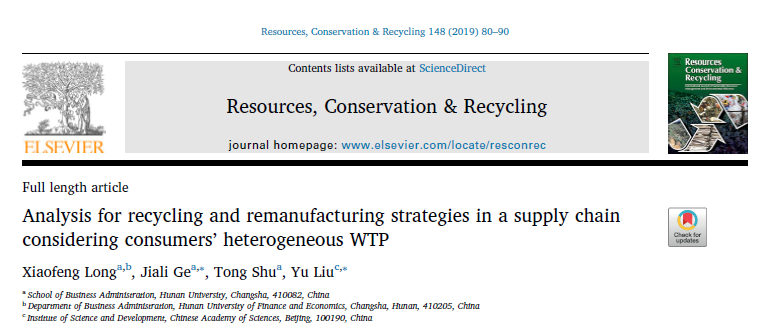
RCR新文:考虑消费者的异质购买意愿的供应链回收与再制造策略分析
原文链接:
https://www.sciencedirect.com/science/article/pii/S0921344919302058
文章导读
闭环供应链是一个封闭的商品供应链,其中商品可以在分销用制造和再制造的方式来循环。收集、回收和再制造过程是闭环供应链的重要组成部分。企业回收消费者手中的旧产品并且通过再制造过程恢复旧产品的剩余价值。在再制造的运营系统中,旧产品通常被看作是输入,经过翻新,再售到市场中。回收和再制造的运营管理是学者和企业管理者关注的热点话题,并且学术界主要关注回收的重要性和给企业带来的效益上。另外,再制造可以为企业节省原材料并产生更多的利润。很多企业例如柯达、惠普和施乐已经开展了产品回收和再制造业务。
尽管再制造有很多经济与环境的价值,再制造品的销售和市场是一个挑战。从消费者的角度来看,他们购买再制造品的意愿较低。消费者对再制造品有不同的价值感知,并且表现出不同程度的购买意愿。这会影响新产品和再制造产品的市场需求,甚至会影响公司的闭环供应链的回收和再制造决策。
1.消费者的购买意愿对回收和再制造决策的影响。
2.比较了制造商的单一和混合再制造策略下的利润和市场绩效。
3.分别分析了单周期和两阶段下制造商的回收和再制造策略和市场绩效。
实证和理论研究表明消费者的购买意愿对制造商的决策具有显著的影响。基于此,我们考虑了消费者的异质性或者说对再制造品的感知不同建立了多个再制造模式的模型,在一阶段和两阶段的闭环供应链的情境下,来确定制造商的最优回收和再制造决策。研究发现,为了获得更高的利润,制造商在一阶段和两阶段都应该参与再制造。在单周期的情境下,制造商的混合制造策略比单一策略更有利,并且制造商选择再制造合作伙伴是根据其再制造成本。在两阶段的情景下,当消费者的购买意愿高于一个特定的阈值时,制造商为了获得更高的消费者剩余、回收率和利润,应该选择第三方机构作为联合回收伙伴。制造商不应该授权分销商来参与再制造活动,因为在这种情况下制造商的利润是最低的。从闭环供应链的角度,本文的研究结果对企业的产品回收和再制造具有一定的政策意义。
原文信息

ABSTRACT
Empirical and theoretical research has shown that consumers’ willingness to pay (WTP) has a significant impact on manufacturers’ decisions. Based on these findings, we establish models for multiple remanufacturing modes considering WTP heterogeneity or different remanufactured products, in one-period and two-period closed-loop supply chain (CLSC) scenarios, to identify the optimal recycling and remanufacturing decisions of manufacturers. We find that manufacturers should participate in remanufacturing in one-period or two-period settings to earn more profits. In the one-period scenario, hybrid remanufacturing is better for the manufacturer than single remanufacturing, and the manufacturer chooses its remanufacturing partner based on the lower remanufacturing cost. In the two-period scenario, when the WTP ratio is above a certain threshold, the manufacturer chooses the third party as its joint recycling partner to obtain higher consumer surplus, a higher recycling rate, and higher profits. If the WTP ratio is high enough, hybrid remanufacturing is better for the manufacturer. The manufacturer does not authorize the distributor to engage in remanufacturing, for this choice yields the lowest profits for the manufacturer independent of WTP ratio. These results have policy implications from the perspective of CLSC cooperative recycling and remanufacturing.
(来源:RCR期刊)
